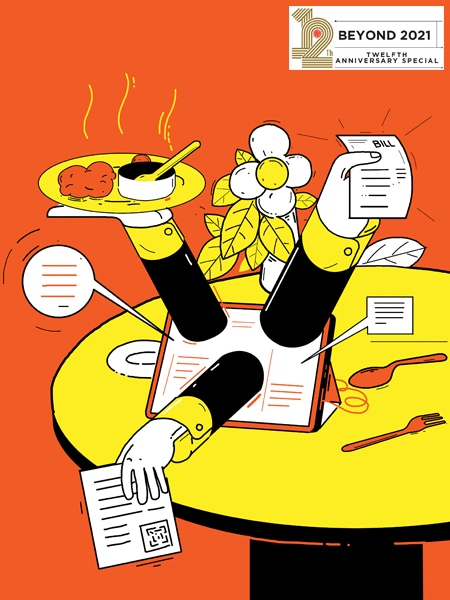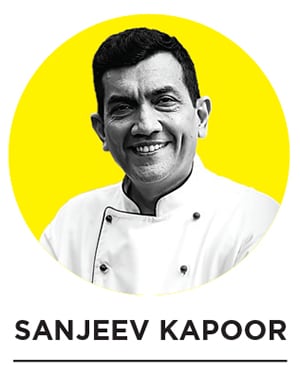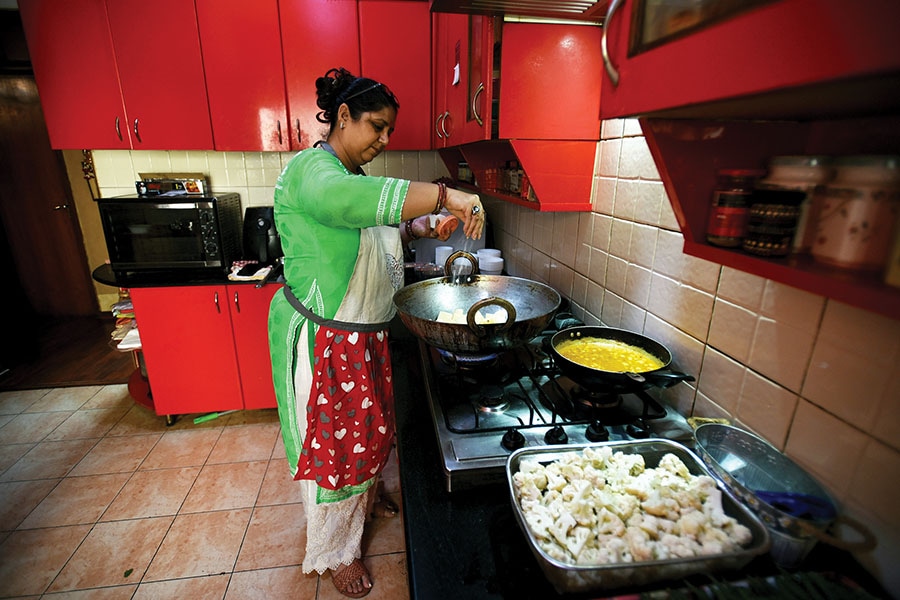It may be a temporary bump and would surely cost a lot, the cost being not only money, but also lives and livelihood. I would say that this is a ‘detox programme’ designed by nature, and each one of us will come out of it stronger. It will take some time to get back on the road and resume businesses at the same pace again but there’s no reason to believe that it won’t be back to normal. People have started to adjust to the ‘new normal’ and we have seen some huge modifications in our industry.
Let’s look at some key trends that have emerged during the pandemic and continue to flourish:
Hygiene, a Top Priority
When we talk about the food industry, the main concern for most people since the pandemic began is safety. One of the most appreciated changes is sanitised services at restaurants, which in my opinion, should be continued now and forever. Right from the pani puri walas to renowned chefs at fancy dine-ins, everyone is wearing gloves, masks and hairnets to ensure maximum safety and sanitisation. The staff is trained to frequently sanitise surroundings and tables for guests at restaurants. Even at gatherings and weddings, waiters are trained and equipped with solid supplies to serve the guests most hygienically.
Concept of ‘Naked Kitchens’
The next trend that is exciting and is here to stay is the concept of ‘naked kitchens’. This is where the kitchen has a full-public view and people can see food being cooked in front of their eyes. This view will level up the public’s confidence in that particular eatery and give them a sense of satisfaction while enjoying their food. For the longest time, one of my biggest concerns of dining out has been unhygienic kitchens in our country that are below acceptable standards. I am extremely thrilled about this new concept and I strongly believe that it should be continued and followed everywhere. I hope, wish and pray that this trend grows exponentially.
![]() Noida resident Parul Sachdeva became a home chef during the pandemic. Through food shows on TV, YouTube and social media, people have learnt to make various dishes and turned their personal kitchens into kitchens for business
Noida resident Parul Sachdeva became a home chef during the pandemic. Through food shows on TV, YouTube and social media, people have learnt to make various dishes and turned their personal kitchens into kitchens for business
Image: Sunil Ghosh / Hindustan Times via Getty Images
Digital Shift
The biggest shift that has happened in the last one year is the exponential increase in use of technology in all aspects of life. Foodtech was no different. Zomato and Swiggy occupied more space in the minds of diners. Restaurants felt that they were being pushed to the wall because Zomato and Swiggy have been squeezing them with higher fees. This prompted restaurants to come together, and with the National Restaurant Association of India taking the lead, there is a movement to reach the diner directly without involving delivery and discovery platforms. This needs time, but it may be a good start for the restaurants. Big hotel chains like Taj with Qmin and ITC have also launched their apps for delivery of food from their iconic restaurants. However, restaurants will need to continue to invest in technology and digital media. My suggestion to the restaurant industry and the delivery platforms would be to work together and try not to burn bridges.
National players like BigBasket, Licious, Fresh to Home, Amazon, Flipkart, JioMart and many more regional players are potential partners for the restaurant industry. However, if it is played right, they all can easily convert into a threat. Licious delivering high quality galouti kabab, BigBasket with its Prasuma Momos, Amazon with its KitFresh Mealkits of restaurant style delicacies... all can eventually eat into the overall restaurant delivery kitty.
Video content has become a big draw for all marketeers, including food. Artificial intellience startups have come up with creative ways to deliver content to the audience, making it simpler. Like, you can ask Alexa for Sanjeev Kapoor’s recipes and get a step-by-step cooking manual with just a voice command.
A robot-themed restaurant in Chennai gained a lot of fame recently where the human staff has been replaced by robots and digital tabs. Many dine-in restaurants have also switched to QR code menus to avoid human touch as much as possible. Other than this, restaurants have tied up with a few delivery apps where customers can make reservations and avoid waiting in queues. The big restaurants, the street food stalls and even the food delivery platforms have insisted on people making contactless payments using digital methods. The story has just begun. Food service players have no choice but to play along and play well.
undefinedThe concept of ‘naked kitchens’ is here to stay. the kitchen will have a full-public view and food will be cooked in front of people’s eyes[/bq]
Rise in Cloud Kitchens
People are still extremely fearful and unsure about dining out at restaurants and that’s where cloud/ghost kitchens come into the picture. Even though people were enjoying ghar ka khana, they also craved experiencing the bliss of a restaurant-style meal. At that point, online delivery platforms offered a plethora of dishes with just a click. While working-from-home, millennials have spent a considerable time scrolling through these delivery apps and ordering regularly. The feasibility that cloud kitchens offer is great: You can order food from anywhere and it gets delivered in no time keeping up with all the safety protocols. It has also opened its arms to street vendors and small-scale fast-food joints that increased their businesses through these apps.
Appreciating Wholesome Indianness
I have always been a flag bearer of Indian cuisine and there’s absolutely no doubt that our indigenous ingredients have magical properties. Ingredients that have been a part of our pantries for ages are immunity boosters, and this pandemic has made everyone realise that. If you talk about the good ol’ masala dabba, we’ve got spices like turmeric, cinnamon, cardamom, pepper, cloves, etc that have been our saviours since our childhood days. I’m sure all these desi spices and other essential foods are the imperative reason we’re healthy, safe and sound, and can tackle the pandemic in the best way.
This also promotes our prime minister’s idea of an Atmanirbhar Bharat, choosing local ingredients instead of foreign ones. In fact, it has also been the other way round people abroad are enjoying the good old haldiwala doodh as ‘turmeric latte’ in an attempt to include Indian immune boosters in their diets. It makes me very happy to see that our people have also started taking health as their top priority.
I was happy to create and curate a menu for Starbucks by blending the goodness of Indian spices into their philosophy of food. It has been hugely appreciated by their consumers, who are primarily young Indians. More and more people have adapted to the concept of mindful eating, where they keep a close check on the kind of food they’re consuming and how it is going to benefit them.
There has been a rise in vegan restaurants and people choosing plant-based products has also led us to be more thankful for our Indian pantries given that most of our desi supplies fall under the vegan category.
As I write this, my friend Puneet Chhatwal, who is the managing director and chief executive of The Indian Hotels Company Limited [which runs the Taj group of hotels], sent me to try and taste their new selection of Innergise meals, a selection of home-style immunity-boosting dishes that they are launching soon for delivery. I must admit I was a little sceptical in the beginning when I read the names of the dishes, but on tasting them, my family and I were pleasantly surprised. I could easily subscribe to this and order it at least five to six times a month.
Restaurants beyond Food and Drinks
Moving forward, new restaurants should start looking at providing more than just food and drinks. It has to be an experience that is unique and unparalleled. A friend of mine who manages hotels in Ibiza, Spain, sent me a clip of a place named LIO and he begged me that we need a place like that in India. A three-minute clip of LIO made me think that maybe the time has come for India to offer luxury experiences, with the best of food, drinks, music, live performances, ambience, service et al.
New Chefs, Opportunities, Agility, Efficiency
There has been a massive increase in the number of home-based chefs. Through food shows on TV, YouTube and social media, people have learnt almost everything and turned their personal kitchens into kitchens for business. Home-cooked meals like dhokla, fafda, dal-chawal, puri-sabzi, etc are being delivered by these chefs at home.
Many restaurant and hotel chefs have lost their jobs and have put their expertise to use and created their own business. Some have started to provide food to the infected families so that they can restore their health with proper home-cooked meals. Some are providing gourmet experiences at home. Since the concept of a big fat Indian wedding has taken a pause, the catering business has come to a full stop. The concept of ready-to-cook mealkits is also trending. There are a lot of ready-to-eat premixes for recipes like idli, dosa, dhokla, poha, upma etc available in the market.
Keeping all these trends in mind, this is the perfect time to become an entrepreneur. India needs more food service and hospitality professionals to turn business owners. They can start small and learn to survive within their means. Once they learn the ropes of the business, they can look at growth. I’m sure we all can get past this and come out stronger than before.
My suggestions to people who are a part of our industry are to be agile, remain open to adjustments and adapt as per new conditions. Attitude will play an important role in identifying newer opportunities and taking them head-on. Efficiency will be critical in all aspects of business. There would hardly be any room for inefficiency.
Manpower will have to be worked upon and re-trained and may be reskilled for multitasking. Cash flow management would be critical. Hence, one has to constantly keep an eye on the ball. The business has to be remodelled where most of the costs should ideally be variable and the fixed cost component is kept to a minimum. The next six-to-nine months may be very tough. Post that, some small recovery may start. Real recovery may happen a bit later.
My mantra for life is, ‘live today but keep planning for tomorrow’. Not just in our personal lives but professionally too. The message to all is to keep experimenting from the comfort of your homes and bring out the best. Don’t put a full stop on your creativity. Utilise this time to the fullest. Post all this, we need to be more cautious and aware about social distancing, hygiene and well-being of each other. Everyone has to become more positive, compassionate, vigilant, and agile, and has to learn to be more sensitive to the consumer as well as employee needs.
â— The writer is a celebrity chef

 Illustration: Sameer Pawar
Illustration: Sameer Pawar I have been part of the food & beverage (F&B) industry for over three decades. I have seen many changes, some good, some not so good, but never could I have imagined that there would be an event in my lifetime that would put India’s F&B service industry in dire straits. Business has been put to ransom by the pandemic. But I still continue to believe the virus is just another hurdle in this race of life.
I have been part of the food & beverage (F&B) industry for over three decades. I have seen many changes, some good, some not so good, but never could I have imagined that there would be an event in my lifetime that would put India’s F&B service industry in dire straits. Business has been put to ransom by the pandemic. But I still continue to believe the virus is just another hurdle in this race of life. Noida resident Parul Sachdeva became a home chef during the pandemic. Through food shows on TV, YouTube and social media, people have learnt to make various dishes and turned their personal kitchens into kitchens for business
Noida resident Parul Sachdeva became a home chef during the pandemic. Through food shows on TV, YouTube and social media, people have learnt to make various dishes and turned their personal kitchens into kitchens for business